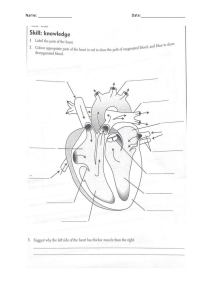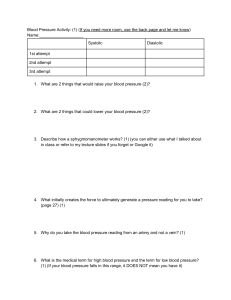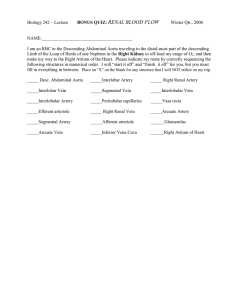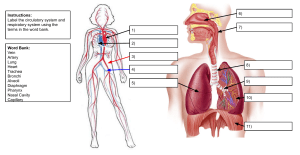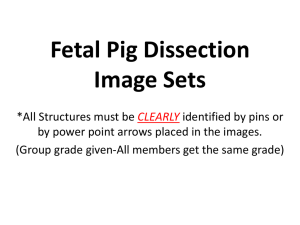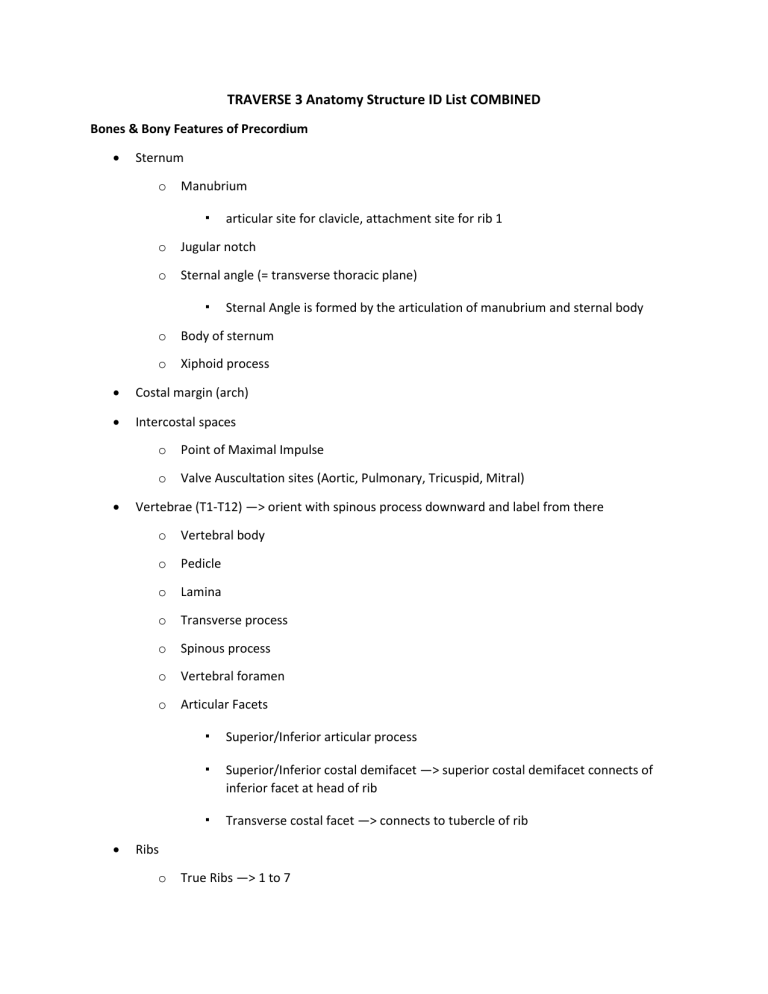
TRAVERSE 3 Anatomy Structure ID List COMBINED Bones & Bony Features of Precordium Sternum o Manubrium ▪ articular site for clavicle, attachment site for rib 1 o Jugular notch o Sternal angle (= transverse thoracic plane) ▪ Sternal Angle is formed by the articulation of manubrium and sternal body o Body of sternum o Xiphoid process Costal margin (arch) Intercostal spaces o Point of Maximal Impulse o Valve Auscultation sites (Aortic, Pulmonary, Tricuspid, Mitral) Vertebrae (T1-T12) —> orient with spinous process downward and label from there o Vertebral body o Pedicle o Lamina o Transverse process o Spinous process o Vertebral foramen o Articular Facets ▪ Superior/Inferior articular process ▪ Superior/Inferior costal demifacet —> superior costal demifacet connects of inferior facet at head of rib ▪ Transverse costal facet —> connects to tubercle of rib Ribs o True Ribs —> 1 to 7 o False Ribs —> 8 to 12 o Floating Ribs —> 11 and 12 o Typical Rib Anatomy: ▪ Head of Rib (with superior and inferior facets) ▪ Neck of Rib —> at front ▪ Tubercle —> at front ▪ Angle —> at top ▪ Costal groove —> at bottom Intercostal spaces Joints o Sternocostal —> at sternal angle o Sternoclavicular —> connection between clavicle and top of manubrium o Costochondral —> connection between costal cartilage and ribs Superior Thoracic Aperture (aka Thoracic Inlet) o Note: Clinically known as the Thoracic Outlet —> brachial plexus pinched in the interscalene space Inferior thoracic aperture Lung auscultation sites (anterior and posterior, Rt and Lt lungs) Muscles Diaphragm o Central Tendon —> need confirm External Intercostal —> on ribcage Internal Intercostal —> on ribcage Innermost Intercostal —> on back of ribcage Sternocleidomastoid Scalene muscles (Anterior/Middle) —> muscles that connect to first rib External oblique Internal oblique Rectus abdominus Neurovasculature Phrenic nerves (Left and Right) Vagus nerves —> between carotid and internal jugular Intercostal neurovascular bundle o Intercostal nerve o Posterior Intercostal Artery o Posterior Intercostal Vein Right and Left Recurrent Laryngeal nerve Sympathetic chain (trunk) Intercostobrachial nerve —> between skin of axilla and 2nd intercostal space Location of trunk dermatomes: T2 —> horizontal of armpits, T4 —> nipples, T10 —> umbilicusub, L1 —> groin Location of pulmonary and cardiac nerve plexus —> pin at carina for cardiac, pulmonary at each bronchi Greater/Lesser & Least Splanchnic nn. Inferior tracheobronchial lymph nodes —> pin below bifurcation of carina Heart and Pericardium Pericardium o Fibrous pericardium o Parietal serous pericardium o Visceral serous pericardium Transverse Pericardial Sinus —> space behind great vessels Oblique Pericardial Sinus —> space between pulmonary veins Retropharyngeal space —> behind pharyngeal muscles Coronary Sulcus Interventricular Sulcus Ligamentum arteriosum —> holds great arteries together Right atrium —> within space contained by pulmonary veins o Right auricle o Pectinate muscle —> rough part o Crista terminalis —> smooth part o Interatrial septum o Fossa ovalis o Opening of Coronary Sinus Right ventricle o Trabeculae carnae o Tricuspid valve o Chordae Tendineae o Papillary Muscles o Septomarginal trabeculae (aka moderator band) o Interventricular septum o Conus arteriosus o Pulmonary valve Left Atrium o Left auricle o Openings of Pulmonary Veins o Interatrial Septum Left Ventricle o Trabeculae carneae o Mitral (Bicuspid) Valve o Chordae Tendineae o Papillary muscles o Interventricular Septum o Aortic Valve Electrical Conduction System of Heart o Locations where SA and AV nodes and electrical pathways are found Coronary Circulation Right Coronary artery Marginal artery (of Right Coronary) Posterior Interventricular artery Left Coronary artery —> more medial Anterior interventricular artery (LAD) Circumflex artery (of Left Coronary) Great cardiac vein —> runs w/ anterior Middle cardiac vein —> runs w/ posterior Small cardiac vein —> runs w/ marginal Coronary sinus (and its opening in Rt atrium) Right, Left and Posterior (non-coronary) Aortic Sinus Lungs Parietal Pleura (including regions adjacent to each subdivision of parietal pleura) o Costal parietal pleura o Diaphragmatic parietal pleura o Mediastinal parietal pleura o Cervical parietal pleura Root of the lung structures o Pulmonary artery o Pulmonary veins o Bronchus Vasculature in Thorax: Ascending Aorta/Aortic Arch/Descending Aorta Pulmonary Trunk Superior Vena Cava (on isolated heart and CV organ bloc) Inferior Vena Cava (on isolated heart and CV organ bloc) Pulmonary Arteries Pulmonary Veins Lower Airway Trachea Bronchi o Primary/Main bronchi o Secondary/Lobar bronchi o Tertiary/Segmental bronchi Carina Right Lung (be able to determine if isolated lung is Rt or Lt) o Superior Lobe o Middle Lobe o Inferior Lobe o Horizontal Fissure o Oblique Fissure Left Lung (be able to determine if isolated lung is Rt or Lt) o Superior Lobe o Inferior Lobe o Oblique Fissure o Cardiac notch o Lingula Endothoracic Fascia —> help Parietal pleura (plus location of each named subdivision of parietal pleura below) o Costal parietal pleura o Diaphragmatic parietal pleura o Mediastinal parietal pleura o Cervical parietal pleura Visceral pleura Root of the lung Hilum of lung Peripheral Circulation Common Carotid artery o Carotid Sinus o Carotid Body Vertebral artery Internal thoracic artery —> vertical arteries in ribcage Posterior intercostal artery Azygos vein Posterior intercostal vein —> need confirm Bones and Bony Features Nasal bones Nasal septum Superior concha Middle concha Inferior concha Hyoid Upper Airway Spaces Nasopharynx Oropharynx Laryngopharynx Nares Choanae Oral Cavity/Pharynx/Larynx Hard palate Soft palate Palatoglossal arch/fold —> need confirm Palatopharyngeal arch/fold —> need confirm Tonsillar bed Tongue Uvula Pharyngotympanic tube opening (aka auditory tube, aka eustachian tube) Cricoid cartilage Cricothyroid ligament —> between crico and thyroid Thyroid cartilage Thyrohyoid membrane —> between hyoid and thyroid Laryngeal prominence Epiglottis Rima glottides Vallecula —> between tongue and epiglottis Aryepiglottic folds —> between arytenoid and epiglottis Piriform Recess —> need confirmation Vocal fold (True Vocal Cords) Vestibular fold (False Vocal Cords) Trachea Tracheal rings Esophagus Muscles Posterior Cricoarytenoid —> behind the vocal folds Cricothyroid —> near the ligament Palatoglossus —> need confirm Palatopharyngeus —> pull up uvula and follow the muscle Salpingopharyngeus —> muscle above the palatopharyngeus Tensor veli palatini —> need confirm Levator veli palatini —> need confirm Pharyngeal constrictors Neurovasculature Internal laryngeal nerve (find superior thyroid artery and find first nerve about it) Facial artery Site of Kieselbach plexus Paranasal Sinuses Frontal sinus Maxillary sinus —> above hard palate and below septum Ethmoid sinus Sphenoid sinus Sphenoethmoidal recess —> slit above the superior concha Superior meatus Ethmoid bulla Middle meatus Semilunar hiatus Interior meatus Mediastinum Superior vs. Inferior Mediastinum Inferior Mediastinum o Anterior o Middle o Posterior It is important to know and ID borders of the compartments, and be able to attribute structures to specific mediastinum compartments (I.e., contents of the compartments). Most structures that you can ID within the mediastinum were on previous structure ID lists in PCV, a few on this list. Neck/Thorax Interscalene Space Anterior Scalene Muscle Middle Scalene Muscle Esophagus Kidneys and Urinary System Adrenal/Suprarenal Gland Right and Left Kidney o Superior Pole o Inferior Pole o Lateral Border o Medial Border Internal Kidney (sectioned) o Renal Cortex o Renal Medulla o Renal Column o Renal Pyramid o Renal Papilla o Renal Sinus Renal Hilum o Renal Vein o Renal Artery o Renal Pelvis Left & Right Renal artery Left and Right Renal vein Left and Right Gonadal artery and vein (aka testicular a/v or ovarian artery a/v) Left suprarenal vein Abdominal aorta Superior Mesenteric artery Common Iliac artery & vein Internal Iliac artery & vein o Umbilical a. (obliterated umbilical a.) o Superior gluteal a. —> between lumbosacral and S1 o Inferior gluteal a. —> between S1 and S2 External iliac artery & vein Rectum Anus Urinary Collecting System o Minor Calyx o Major Calyx o Renal Pelvis o Ureters Urinary Bladder —> need help with all of this o Base o Trigone o Ureteric Orifices o Internal Urethral Orifice (at bladder neck) o Internal Urethral Sphincter Phenotypic male donors o Intramural urethra (aka preprostatic) o Prostatic urethra o Membranous (urethra aka bulbar, intermediate) o Penile urethra (aka spongy) o External urethral orifice o Glans penis o Corpus spongiosum —> paired o Corpus cavernosum —> only one, surrounds the urethra o Prostate —> inferior to bladder o Ductus (vas) deferens o Seminal vesicles Phenotypic female donors o External urethral orifice o Clitoris o Vagina o Vaginal opening o Vestibule of vulva o Labia minora o Labia majora o Uterus Nerves o Lumbosacral trunk o S1-S2 Ventral Rami o Sympathetic chain and paravertebral ganglia —> don’t know location (in abdomen) Muscles o Psoas major muscle —> thick muscle near the external iliac artery o Quadratus lumborum o Transversus abdominis —> runs horizontal in abdomen o Diaphragm o Levator ani (part of pelvic diaphragm) o Obturator internus m. (under tendinous arch) o Tendinous arch (fascia in the pelvis) o Urogenital hiatus —> space the urethra runs through o Piriformis m. (between S1 and S2) —> near gluteal arteries Bones o Pubic symphysis o Pubic tubercle —> bump near pubic symphysis o Pelvic brim —> inner circle o L1 vertebra (= transpyloric plane) —> vertebra where there’s no rib o Transverse process (of lumbar vertebrae) o Costal margin o Floating ribs (ribs #11-12) —> 2 ribs still within the body Peritoneal Recesses (location of spaces and ID structures that border the spaces) o Vesicouterine pouch (female) o Rectouterine pouch (female, = Douglas pouch) o Rectovesical pouch (male) o Hepatorenal recess (= Morrison’s pouch) o Splenorenal recess o Rt/Lt paracolic gutters
